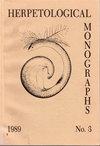古巴东部棘足猴三新种,附其他种的发声记录(无尾目:细足猴科)
IF 1.1
2区 生物学
Q3 ZOOLOGY
引用次数: 20
摘要
描述了古巴东部高地地区三种新的树栖伊柳蛛。Eleutherodactylus guantanamera在关塔那摩省分布较广,也出现在古巴圣地亚哥省,E. mariposa仅在Meseta del Guaso(关塔那摩省)的类型地区已知,E. melacara仅在古巴圣地亚哥省的Pico Turquino已知。这些物种中的两个,E. guantanamera和E. melacara代表了古巴已知的第一批凤梨科专家,它们具有在其他凤梨科栖息物种中发现的头部形状和眼睛方向。讨论了古巴这一树栖亚属的所有10个成员的呼叫和染色体变异。在西印度群岛有两个大而广泛分布的亚属:大蛙属(80种)和大蛙属(44种),还有一个小亚属(Pelorius;6种)在伊斯帕尼奥拉岛(赫奇斯,1989)。分子证据表明,这两个大亚属的分化发生在白垩纪晚期或新生代早期(Hass和Hedges, 1991)。虽然每个亚属的成员都入侵了广泛的生态位,但这两个类群可以通过其主要的生态习性来表征。土狗亚属的物种通常占据陆地生态位,通常在靠近地面或岩石上发现。几乎总是在西印度群岛的刺尾龙亚属的一种本文章由计算机程序翻译,如有差异,请以英文原文为准。
THREE NEW SPECIES OF ELEUTHERODACTYLUS FROM EASTERN CUBA, WITH NOTES ON VOCALIZATIONS OF OTHER SPECIES (ANURA: LEPTODACTYLIDAE)
Three new arboreal species of Eleutherodactylus are described from upland regions of eastern Cuba. Eleutherodactylus guantanamera is relatively widespread in Guantanamo Prov- ince and also occurs in Santiago de Cuba Province, E. mariposa is known only from the type- locality on the Meseta del Guaso (Guantinamo Province), and E. melacara is known only from Pico Turquino in Santiago de Cuba Province. Two of these species, E. guantanamera and E. melacara represent the first bromeliad specialists known from Cuba, and they possess a head shape and eye orientation found in other bromeliad-dwelling species. Call and chromosome variation are discussed for all 10 members of this arboreal subgenus in Cuba. THE grandiose frog genus Eleuthero- dactylus (>500 species) is represented in the West Indies by two large and wide- spread subgenera, Euhyas (80 species) and Eleutherodactylus (44 species), and one small subgenus (Pelorius; six species) on Hispaniola (Hedges, 1989). Molecular ev- idence suggests that the divergence of the two large subgenera occurred in the late Cretaceous or early Cenozoic (Hass and Hedges, 1991). Although members of each subgenus have invaded a wide range of ecological niches, these two groups can be characterized by their predominant eco- logical habits. Species in the subgenus Eu- hyas usually occupy terrestrial niches and commonly are found close to the ground or on rocks. West Indian species of the subgenus Eleutherodactylus nearly always
求助全文
通过发布文献求助,成功后即可免费获取论文全文。
去求助
来源期刊

Herpetological Monographs
生物-动物学
CiteScore
5.40
自引率
0.00%
发文量
2
审稿时长
>12 weeks
期刊介绍:
Since 1982, Herpetological Monographs has been dedicated to original research about the biology, diversity, systematics and evolution of amphibians and reptiles. Herpetological Monographs is published annually as a supplement to Herpetologica and contains long research papers, manuscripts and special symposia that synthesize the latest scientific discoveries.
 求助内容:
求助内容: 应助结果提醒方式:
应助结果提醒方式:


